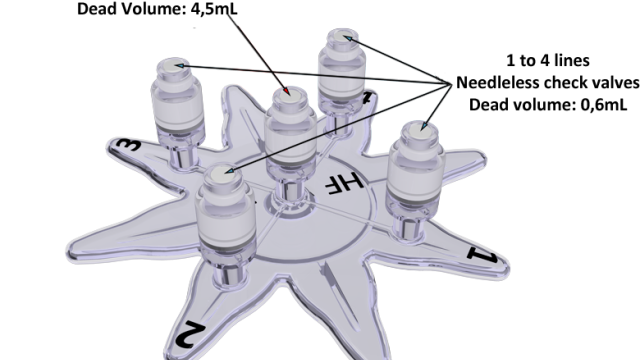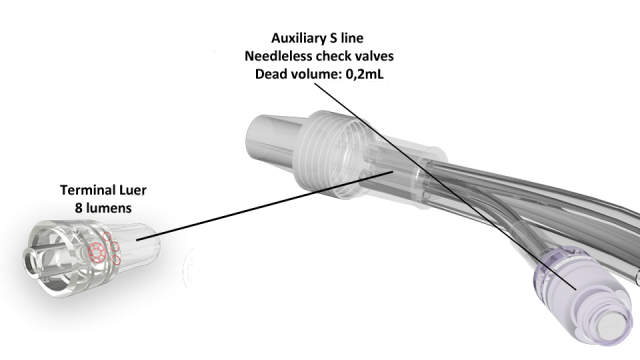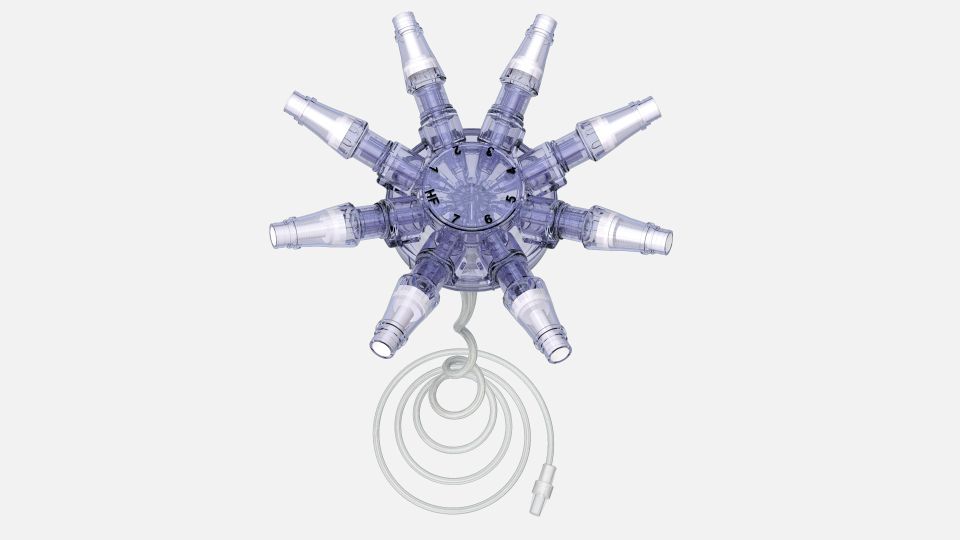Edelvaiss® Multiline Range
Doran International specialises in the creation and development of infusion sets and has been developing innovative solutions to meet the daily challenges of healthcare professionals for over 25 years now.
The Edelvaiss® Multiline is the result of this collaboration.Its innovative technology is transforming the way liquid drugs are administered in patient care.
With up to 11 separate lumens, the Edelvaiss® Multiline range can deliver treatments to the patients catheter without mixing.Its unique architecture reduces drug incompatibilities in the catheter, which significantly reduces their consequences.With the Edelvaiss® Multiline, drug delivery is safer and more efficient than with any other infusion device.Its closed one-way ports prevent air from entering the system and causing a drug backflow.
Due to its very low common volume, this device reduces administration disturbances (bolus, slowing down, speeding up) when infusing several drugs simultaneously.The Edelvaiss® Multiline, with its 21-day period of use, offers a complete and durable infusion line for every patient, from neonates to adults.
The management of premature newborns has inspired us to develop a new and innovative approach based on our initial device.
The Edelvaiss® Multiline NEO has been specifically developed for this field, in order to meet the needs of premature newborns and the problems associated with their management.
This solution has a therapeutic as well as economic impact, as it can be used safely for a long period of time, it reduces the quantity of plastic material waste.

Insulin itself interacts slightly with PVC, but its preservatives such as phenol and metacresol interact particularly with PVC which can be problematic during administration. Therefore, it is recommended to use medical devices made of PE or PE / PVC.
The use of an optimized infusion circuit such as Edelvaiss® Multiline with a dedicated insulin infusion line helps minimize the occurrence of hypoglycaemic events. This type of device improves patient safety when administering insulin in perioperative care.
When several drugs are infused simultaneously through an intravenous line, side effects such as boluses or deceleration of the administration frequently occur. Compared to a conventional manifold with a large common volume, the use of Edelvaiss™ Multiline, a device with a very low common volume, considerably reduces the disturbances linked to the stopping and restarting of drugs.
In this study, it is demonstrated that the architecture of the infusion manifold has an impact on the biological response in vivo and on the the drug delivery rate after modification of the infusion rate set at the pump Devices with low common volume greatly improve response times.
Through this study, it is shown that hemodynamic stability is achieved more quickly thanks to these new devices with low common volume. In addition, caregivers respond more effectively to hemodynamic instability when using a device with low common volume.
The premature infant is more prone to hypothermia <37.5°C. This study evaluates a cohort of 8,782 infants born prematurely. 56.2% of these patients presented with moderate to severe hypothermia. The risk assessment showed a positive correlation between moderate hypothermia and risk of intraventricular haemorrhage, severe hypothermia and risk of death.
The general environment of the intensive care unit is a source of stress for premature infants. In the unit, premature infants experienced a high degree of pain / stress, both in terms of number of acute daily events (22.97 ± 2.30 interventions) and cumulative durations of chronic and stressful exposure (42 , 59 ± 15.02 hours). Both acute and chronic stresses experienced early in life have significantly contributed to a deficit in neurobehavioral outcomes.
Caregivers in neonatal intensive care are exposed to different sources of stress. This study involves an assessment of stress secondary to trauma on 175 neonatal intensive care nurses. 49% of nurses showed a moderate to severe STSS stress score. One of the recurring themes in the generation of stress is practicing painful gestures to newborns.
Newborns admitted to neonatal intensive care are exposed to multiple sources of pain, such as the insertion of arterial or venous catheters. To control the pain, opioids may be given to patients. This study demonstrates the correlation between the dose of opioids received during the stay and cognitive development at 20 months...
In this study, it appears that the characteristics of the infusion circuit have an impact on the physical incompatibility between two drugs. Under certain conditions the Edelvaiss™ Multiline prevents physical incompatibilities between Furosemide and Midazolam.
This study tells us that the choice of the concentration of the drug administered, but also the type of infusion device, can significantly reduce the risk by lowering particulate contamination (-68%).
Check valves provide safety and reliability of administration :
- by preventing retrograde flow of liquid and flushing effects.
- by improving the administration stability during low-rate infusion.
The level of microbial contamination is significantly higher in incubators with high temperature (≥34 ° C) and high humidity (≥60%) especially in cooler areas of the incubator which are real hotspot of microbial contamination.
CLABSI are responsible for significant morbidity and mortality. In 2012, over the study period 454 (sepsis or Bacteremia linked to catheters regardless of the event occurring first) on CVC were identified, an incidence of 20.4 p 100 CVC (95% CI [18.5 - 22.3]), and an incidence density of 16.1 / 1000 d-CVC (95% CI [14.6 - 17.5]).
Download PDFHospital-acquired infections are a real problem in neonatal care in terms of morbidity and mortality.These also have an impact on the average hospitalization time, which increases on average by 16 days, generating an average additional cost of € 11,750 per patient.
We learn from this study that exposure of preterm infants to infections before and / or soon after birth has a real impact on the incidence of cerebral palsy (CP). A strategy to reduce the number of post-natal infections should be put in place in wards, which should reduce the number of CP at 5 years.
These compounds are known to have an impact on health. BPA for its activity as an endocrine disruptor increasing the risk of diabetes and autoimmune disease, etc. Phthalates are recognized as having an impact on neurodevelopment in neonatology but also as an endocrine disruptor, etc.
Download PDFDevelopment of hypersensitivity to latex is a reality in neonatology with newborns who have undergone exposure quickly after birth, in particular during surgery (spina bifida, gastroschisis / omphalocele, post-hemorrhagic or congenital hydrocephalus) or during their hospitalization. Exposure to latex should be avoided in the neonatal intensive care unit.
Download PDF












